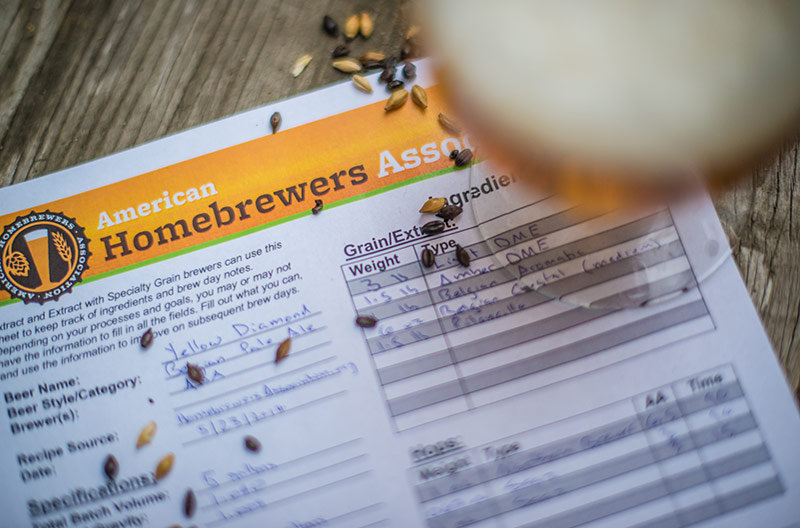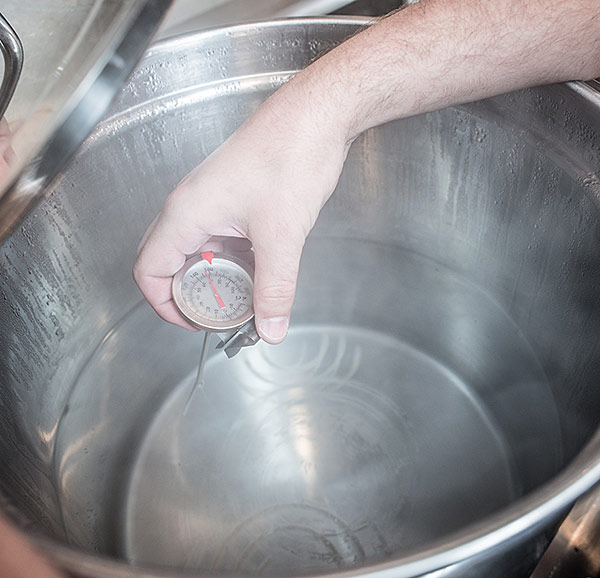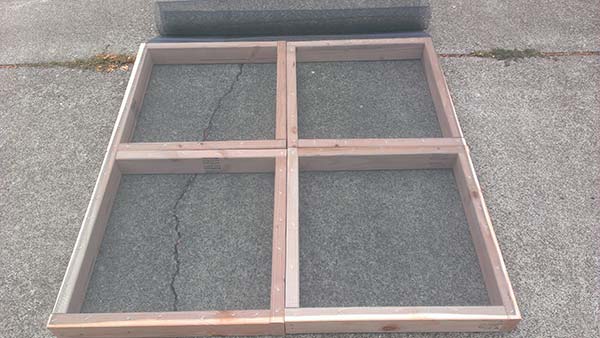#homebrew Brew Boss Electric Homebrew Equipment EBIAB www.brew-boss.com #thebeernation

What Is A Partial Mash
Essentially in partial #mashing you are getting a portion of the fermentable sugars for the wort from a mix of base and specialty grains. It is anything but difficult and requires only a little more time and attention to detail compared to steeping grains. The only extra piece of equipment which maybe required is a good thermometer. You may also consider adding a bigger brew kettle to hold the entire volume of wort, a strong nylon bag to hold the grains, a device to quickly chill your hot wort to pitching temperature, and an aquarium pump and aeration stone to add oxygen to the wort.
Mashing (Partially)
Mashing is a simple process, but one that is often made to seem overly complex in some homebrewing texts. The essence of mashing is simply soaking crushed grains in water. As the grains soak, the water dissolves the starch in the grains. Enzymes from the grain attack the starch and chop it up into its building blocks, sugars. Once the starch is fully converted, the sugars are rinsed from the spent grains.
As far as starch-conversion goes, a partial mash works exactly like a full mash. However, since less grain is used in a partial mash, handling the soaking and rinsing of the grains is simpler and requires no special equipment beyond a mesh grain bag and a measuring cup. Performing a partial mash is very similar to steeping specialty grains. Gaining some experience with partial mashing often encourages brewers to go on to
try making an all-grain beer.
Why Partial Mash?
So why perform a partial mash? That's a little harder to answer but lies in the type of grains a recipe may require when it was originally designed as an all-grain brew. If an all-grain recipe calls for a modest to high percentage of unmalted grains (examples: flaked grains or torrified grains) or non-steeping specialty grains (example: biscuit malt, aromatic malt, honey malt, etc…), or uses a base grain that does not have a malt extract equivalent (example: rauch malt, Vienna malt, mild malt, etc...), then it is a good candidate for making a partial mash.
As already mentioned, in mashing the starch in the center of malted grains is broken down into its constituent sugars. By adding in some base grains with the unmalted or specialty grains, we get the enzymatic power to convert the starch into sugar, which the unmalted or specialty malt would be incapable of doing on its own. Here at BYO we always try to simplify all-grain recipes that have been submitted to an extract format for home brewers. Some all-grain recipes easily can be converted to extract only, some require the use of steeping grains like crystal or roasted malts, while some require performing a partial mash and some just really can't be converted at all.
Performing a Partial Mash
In a partial mash, the goas is to steep the grains in a volume of water sufficient to cover them completely, but not leave a lot of excess volume. For our partial mash stout we'll steep 1.5 pounds (0.68 kg) of pale malt, plus the equivalent amount of specialty grains, in 2 gallons (7.6 L) of water. This is a thinner mash than most full mashes, but that won't adversely affect our beer.
To begin the partial mash, gather the crushed grains and place them in the nylon bag. Although we will be holding the temperature of the mash at 150 °F (66 °C), we need to heat the water to 160 °F (71 °C) to start. This is because the temperature of the mash will drop once the grains, which are at room temperature, are added to the liquid. Once the grain bag has been submerged for a couple minutes take the temperature of the water in the pot and you can add heat or cold water to adjust the temperature of the mash if needed. Try to hold the temperature as close to 150 °F (66 °C) as possible for 1 hour. If the pot you are mashing in is oven safe, you may consider placing the mash in your oven at "keep warm" or about 150 °F (66 °C).
As you heat a pot, it takes time for the heat to travel through the metal and equilibrate. Thus, if you heat the mash continuously until the thermometer reads 150 °F (66 °C), then turn off the burner, the temperature will keep rising as heat from the pot is transferred to its contents. To avoid this, heat the mash in short bursts, stir while heating, and wait a couple of minutes before checking the temperature again. It's not going to hurt the beer if it takes you a little while to adjust the temperature, so be patient.
Rinsing the Grains (Sparging)
After an hour, take a large kitchen strainer and lift the bag out of the water. Let the liquid drain into your pot. If possible, balance the strainer over the pot. If you can't do this, have a friend hold it. Make sure that the grains are exposed before you begin rinsing them. Take a measuring cup and ladle hot water over the grains. The water will run through the grains rinsing out the sugar still trapped in the grain. Keep doing this for 5 minutes or so. The idea here is to rinse (sparge) as much of the sugars from the grains as possible. A good rule of thumb is to run an equal amount of rinsing water as you added initially to the mash, so 2 gallons (7.6 L) for our stout.
Full-Wort Boil (Optional)
The remainder of the suggestions in this article are for those folks stepping up to full-wort boils as well as a solid recipe for 1st time (or 20th time) partial mash brewers. While not a necessity, we do highly recommend full-wort boils, not just for partial mash brewers, but for all homebrewers for the reasons listed below. For more reading and recipes on partial mash brewing, we recommend checking out these two great articles by Chris Colby,
first this as well as
this one.
Reasons to Perform a Full-Wort Boil
In your large brewpot — it should hold at least 8 gallons (30 L) of liquid — combine the wort from the partial mash with water to make 5.5 gallons (21 L). Bring this to a boil, then add the malt extract. Although our target is 5 gallons (19 L) of wort, we need more wort initially because some liquid will evaporate during the one-hour boil. The amount that evaporates is dependent on the amount of heat applied to the kettle. If you're boiling on the kitchen stove, the evaporation may be minimal; if you're using a propane burner, it may be considerable.
Boiling 5 gallons (19 L) of wort is a large task for most home stoves. A gas stove can probably bring this volume of wort to a rolling boil. An electric stove may have problems developing more than a sustained simmer. Also, the amount of time it takes for the wort to come to a boil may be quite long. You may wish to begin heating the additional water while you are performing the partial mash. If your kitchen stove is having trouble boiling this volume, close the lid partially.
Two benefits of boiling the entire wort are increased hop utilization and less wort darkening compared to boiling a concentrated wort. When brewing a beer using a full-wort boil, you need to add fewer hops to get the same level of hop bitterness. This is because more hop bitterness is extracted in more dilute worts. With a full-wort boil, you can also brew beers that are much lighter in color than beers brewed with from a concentrated wort. In thicker worts, the sugars carmelize much easier, darkening the wort. This difference in color won't be very visible in any darker colored beer though.
Another change that a full-wort boil will bring is the inability to pour the wort directly into the fermenter. (Pouring boiling wort into a glass carboy, for example, could crack the glass.) With no cold water to dilute the wort and bring down the temperature, you will need to cool the wort first. Then, given the large volume, it's more convenient to simply siphon the wort to the fermenter.
This drawback, however, has a hidden benefit. Since siphoning the wort to a fermenter leaves behind material on the bottom of the kettle, you don't need to keep your hops in a bag or tea ball. The hop debris will settle to the bottom of the kettle during cooling. The clear wort can then be siphoned off the hop material and hot break, the proteins, lipids and other compounds that coagulate in the boil.
Cooling your Wort
There are several ways to cool wort. One way is to place the kettle in a sink or bathtub full of cold water and ice. The drawback of this method is that you need to lift a large volume of near-boiling hot liquid. Needless to say, this can be a bit dangerous. You can avoid the potential hazard of spilling 5 gallons (19 L) of hot wort by chilling it on the stovetop with a submersible wort chiller.
A submersible wort chiller is a spiral of copper or stainless steel tubing. This tubing is submerged in the wort and cold water is run through it. Heat from the wort transfers to the cold water and is carried out. The speed of cooling and the eventual temperature the wort reaches depends on the temperature of the cooling water.
You can speed chilling by gently whirlpooling the wort. If the submersible wort chiller is left undisturbed, the wort next to the copper coils will quickly cool. However, the wort farther away from the coils will cool much more slowly. The wort will move somewhat in that cold wort will sink and warmer wort will rise. But, starting a whirlpool will greatly enhance the amount of hot wort passing by the copper coils and greatly enhance your cooling rate.
If you move the submersible wort chiller in a circular motion, you will start the wort moving. As the wort moves by the cool chiller, it cools. Hot wort is prone to hot-side aeration, so try not to agitate it unduly. Induce a slow, steady swirling motion by moving the wort chiller in a circle. Repeat this motion every five minutes.
The wort chiller is usually sterilized by submersing it in the wort for the final 15 minutes of the boil. During this time, there is no water flowing through it. In fact, it's best not to connect the tubing until after you have turned off the heat to the kettle. A logistical note: Connecting the tubing to your sink faucet will probably require an adapter, since most wort chillers are threaded to screw onto a garden hose connector.
Aerating the Wort
Performing a full-wort boil necessitates one other change in your brewing procedure; you should aerate your wort once it is cool. When extract brewing, we simply add cold, aerated water to our concentrated wort to aerate it. Now we can't do that, because our wort is already at working strength. Adding water would dilute it.
One of the simplest ways to aerate cooled wort is by using an aeration stone attached to an aquarium pump. Most aeration "stones" used in brewing are actually made of stainless steel. Air is pumped into the stone, where it is forced out through hundreds of tiny holes. Air from the aquarium pump should be filtered, so you are not pumping airborne microorganisms into your wort. Most homebrew shops sell aeration kits that include the stone and a HEPA filter. Since the aeration stone and the tubing leading to it will touch the wort, you must sanitize both before you aerate.
You can aerate your wort while it is siphoning into your fermenter. Just put the aeration stone in the fermenter and run the aquarium pump as you are siphoning. By the time your fermenter is filled, the wort should have enough oxygen. If you'd like, you can run the pump for another five or ten minutes. However, keep an eye on the wort so the bubbles from the aeration stone don't make the wort foam over.
Dry Irish Stout
OG = 1.048 FG = 1.014
IBU = 30 ABV = 4.6%
Ingredients
3.5 lbs. (1.6 kg) extra light dried malt extract
1.5 lbs. (0.68 kg) pale ale malt (Maris Otter is preferred)
1.5 lbs. (0.68 kg) flaked barley
1 lb. (0.45 kg) roasted barley
9 AAU Fuggles hops (60 min.)
(2 oz./57 g of 4.5% alpha acids)
Wyeast 1968 (Londong ESB Ale) or White Labs WLP002 (English Ale) or Safale S-04 yeast
3/4 cup corn sugar for priming
Step by Step
If you opt to use one of the liquid strains, then 4 days before brew day
make a 1-L yeast starter. Refrigerate yeast starter 1 day prior to brew day and decant the liquid just prior to pitching the yeast.
On brewing day, heat 2 gallons of water to 160° F (71 °C). Steep the crushed pale ale malt and flaked barley for 45 minutes. Hold temperature at 150 °F (66 °C). Add the crushed roasted barley to the nylon bag and hold for 5 more minutes. Place grain bag in a kitchen strainer and rinse grains with approximately 2 gallon (7.6 L) hot water. Top off to 6 gallons (23 L) of wort and heat. Stir in malt extract (preferably while heat is turned off momentarily to avoid scorching) then bring wort to boil. Add the bittering hops and boil for 60 minutes. Turn off the heat then cool wort with wort chiller (or cold tub of water). Siphon cooled wort to fermenter. Aerate wort with aquarium pump, stone and filter, then pitch yeast. Ferment for one week at 68 °F (20 °C). You can then rack the beer to a secondary if you prefer, but this is an optional step. Two weeks after brew day test specific gravity with hydrometer for 3 straight days. If the specific gravity remains constant, go ahead and bottle, adding the priming sugar to your bottling bucket. After bottling, condition for 2 weeks, preferably in a slightly warmer than normal room. Your beer should now be fully carbonated and ready for you to enjoy. Cheers!
https://byo.com/newbrew/partial-mash








 Given the name, it feels strange that Belgian pale ales don't have a lot in common Belgian strong pale ales. These actually more closely resemble English pale ales—amber to copper in color with a toasty malt quality and a moderate strength (around 4.5 to 6% ABV). Expect a fruity and peppery yeast aroma that's more subdued than most Belgian ales, with a mild earthy hoppiness that may poke through on the finish.
Given the name, it feels strange that Belgian pale ales don't have a lot in common Belgian strong pale ales. These actually more closely resemble English pale ales—amber to copper in color with a toasty malt quality and a moderate strength (around 4.5 to 6% ABV). Expect a fruity and peppery yeast aroma that's more subdued than most Belgian ales, with a mild earthy hoppiness that may poke through on the finish.




 Inspired by coaching one of my coworkers through his first batch of homebrew (an English bitter) to write up a list of the mistakes that many new homebrewers make. Several of these are things I did on early batches, while others I have tasted at homebrew at club meetings. Many of these issues stem from poor kit instructions, bad homebrew shop advice, and common sense that just doesn’t work out.
Inspired by coaching one of my coworkers through his first batch of homebrew (an English bitter) to write up a list of the mistakes that many new homebrewers make. Several of these are things I did on early batches, while others I have tasted at homebrew at club meetings. Many of these issues stem from poor kit instructions, bad homebrew shop advice, and common sense that just doesn’t work out. 5. Using liquid yeast. "Pitchable" liquid yeast cultures barely have enough cells to ferment a standard gravity beer on the day they are packaged, and their cells die quickly from there. A high quality 11.5 g package of dried yeast starts with as much as twice the cells as a fresh package of yeast from either Wyeast or White Labs, and retains high cell viability for much longer. While Fermentis, for example,claims a minimum of 6 billion cells per gram at packaging, the actual number tends to be much higher. Liquid yeast can produce great beers, but require a starter unless you are getting extremely fresh yeast and brewing a low-alcohol beer.
5. Using liquid yeast. "Pitchable" liquid yeast cultures barely have enough cells to ferment a standard gravity beer on the day they are packaged, and their cells die quickly from there. A high quality 11.5 g package of dried yeast starts with as much as twice the cells as a fresh package of yeast from either Wyeast or White Labs, and retains high cell viability for much longer. While Fermentis, for example,claims a minimum of 6 billion cells per gram at packaging, the actual number tends to be much higher. Liquid yeast can produce great beers, but require a starter unless you are getting extremely fresh yeast and brewing a low-alcohol beer.











 At this point, you should pick your hops into sacks and weigh them. It is always more fun to have a helper. Place a single variety into a single (screened) tray. Once your tray is full (about 1/3 up the side), set it on top of the base tray over the fan so that the tray edges align perfectly over each other. Continue to pick your hops, fill your trays and stack them up. Leave one of the trays empty to the side. I used a piece of masking tape to mark each tray to know which variety was in which tray. Next year, I may just add a plastic sleeve to the side and make up cards with the names of the varieties I grow to sort them that way (it will look much nicer).
At this point, you should pick your hops into sacks and weigh them. It is always more fun to have a helper. Place a single variety into a single (screened) tray. Once your tray is full (about 1/3 up the side), set it on top of the base tray over the fan so that the tray edges align perfectly over each other. Continue to pick your hops, fill your trays and stack them up. Leave one of the trays empty to the side. I used a piece of masking tape to mark each tray to know which variety was in which tray. Next year, I may just add a plastic sleeve to the side and make up cards with the names of the varieties I grow to sort them that way (it will look much nicer).